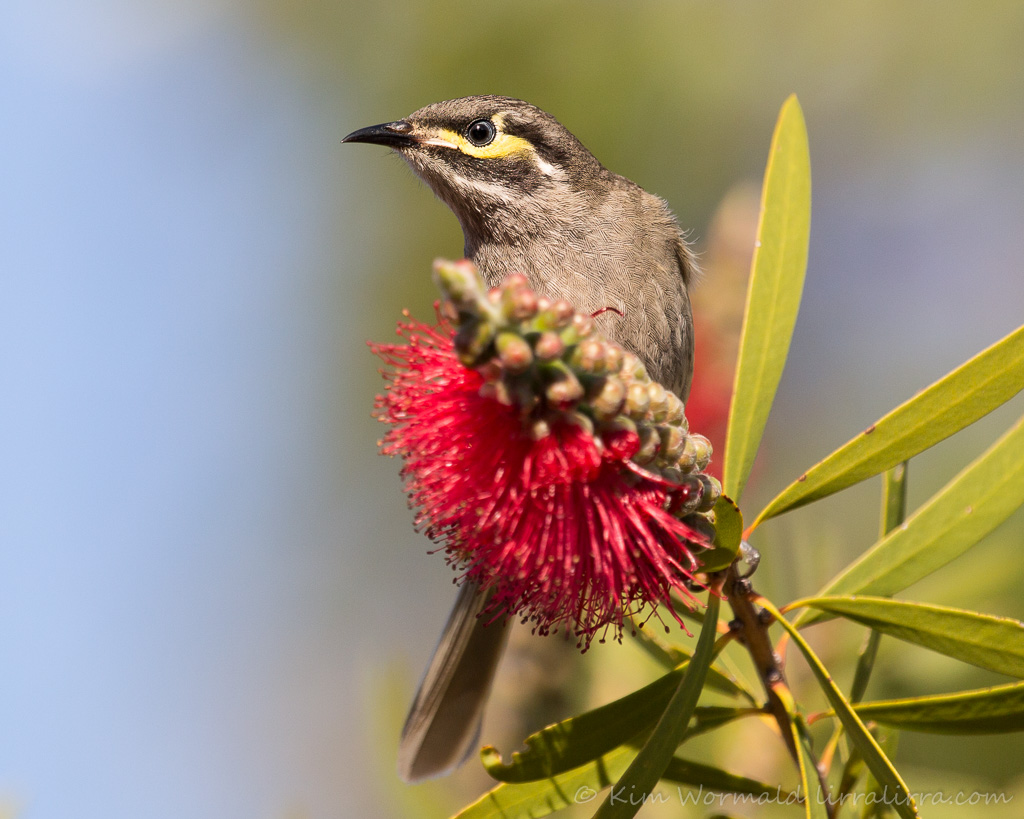In May last year I posted a tribute to Tom Oliver in the post Silvereye Triptych and mentioned that an award was being set up in his name. Details of the award were announced recently and I hope the organisers are inundated with fine entries – check out the link at the bottom of the page, the winner could be you!
 Yellow-faced Honeyeater (Lichenostomus chrysops)
Yellow-faced Honeyeater (Lichenostomus chrysops)
Canon 5DIII, 100-400mm L IS USM, 1/1000, f/6.3, ISO 400, focal length 390mm
I wasn’t sure which images to share for this post but suddenly realised it had to be the Yellow-faced Honeyeater, above, and the Little Wattlebird, below. I wanted images that were somehow linked with Silvereyes and these birds appeared briefly while I was taking the Silvereye shots that featured in Bottlebrush Posers.
Yellow-faced Honeyeaters are small honeyeaters measuring about 16cm and weighing 16g, they are considerably larger than Silvereyes. They eat a range of food including nectar, fruit and insects. They have a happy chirruping call and can be found from South Australia up to northern Queensland. I usually only see a couple at a time but today five appeared and I’m hopeful that three of them were fledglings.
 Little Wattlebird (Anthochaera chrysoptera)
Little Wattlebird (Anthochaera chrysoptera)
Canon 5DIII, 100-400mm L IS USM, 1/1000, f/6.3, ISO 400, focal length 390mm
Little Wattlebirds are significantly larger than Yellow-faced Honeyeaters, measuring 28cm and weighting a mighty 62g – which is still only as much as a hen’s egg. They have a brush-tipped tongue which they use to probe into flowers and gather nectar. Little Wattlebirds are found in similar areas to the yellow-faced except they are missing from parts of northern Queensland and present in south-west Western Australia and in Tasmania. They have a strange semi-raucous semi-musical call that is less harsh than the call of the widespread Red Wattlebird.
Visit the Tom Oliver Award if you would like details about the award (which is open to all Australians). If I can help in any way please let me know.
Happy birding and good luck, Kim
~ Thank you for your visit and comments.
~ If you’d like to receive a weekly email informing you that lirralirra has been updated please add your email address to the ‘subscribe’ box above right.

Can’t say it enough – I love love love Australian birds (and those that share the photos). You have such interesting and pretty birds and I’m so impressed by your photos of them. You have amazing patience!
Let me know if you visit Melbourne Sherry so I can take you bird watching
Lovely sharp photos, Kim. Always a joy to view your photos.
Thank you Carole, and it’s always a joy to view your comments
Fantastic shots. Wonderful detail. I really enjoyed reading “beginnings” – not sure why I had not read it on previous visits.
Thank you Dave, and thanks for letting me know you enjoyed ‘beginnings’. I read it again myself after reading your comment and it brought back some good memories.
Stunning images Kim. I feel as if I can reach out and touch the Little Wattlebird’s feathers. I love the composition of that photo, and the contrast of colour between the bird and the green and red. Aesthetically, very pleasing!
The feathers of the Little Wattlebird fascinate me, the pattern is so interesting. I’m rapt that you like the image
That’s a bit odd that the little wattle bird is the bigger of the two! How informative
It is odd and I hadn’t even realised!
My goodness Kim these photo’s are absolutely beautiful, amazing the way you have captured such great detail of their feathers , so easy on your eye’s, gives me a thrill each time I open this site, Thank you for this. Love Dona
Thanks for your lovely comment Dona, I’m working on the calendar at the moment and will hopefully be able to include some of your favourites xo
Stunning images – as always.
We get the Red Wattlebirds here. They wake me up considerably before sparrow-fart, gorge themselves on my mulberries (and decorate the paths with indelible stains), and swoop me and the cat. And I love them.
They sound like a big part of your life!